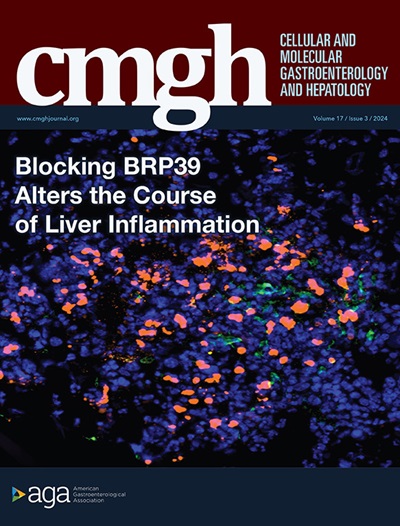Cytomegalovirus Worsens Necrotizing Enterocolitis Severity in Mice via Increased Toll-Like Receptor 4 Signaling
IF 7.1
1区 医学
Q1 GASTROENTEROLOGY & HEPATOLOGY
Cellular and Molecular Gastroenterology and Hepatology
Pub Date : 2025-01-01
DOI:10.1016/j.jcmgh.2025.101473
引用次数: 0
Abstract
Background and Aims
Necrotizing enterocolitis (NEC) is a life-threatening condition in premature infants, marked by acute intestinal necrosis. NEC develops in part after activation of the lipopolysaccharide receptor toll-like receptor 4 (TLR4) by intestinal microbes in the intestinal epithelium. Previous authors have shown an increased risk of NEC in human infants after cytomegalovirus (CMV) infection, which can affect mitochondrial function. We now seek to explore the impact and the mechanisms of CMV infection on NEC severity and its relationship with TLR4 signaling and mitochondria function.
Methods
NEC was induced in newborn mice with and without CMV infection. RNA sequencing and gene set enrichment analysis were performed to identify effects on inflammatory and metabolic pathways. The role of TLR4 signaling and mitochondrial function were investigated in wild-type and Tlr4-deficient mice. The adenosine receptor agonist 5'-N-ethylcarboxamido adenosine was tested for its ability to reduce CMV-induced effects on NEC severity.
Results
CMV infection significantly increased NEC severity in wild-type mice. Mechanistically, CMV infection triggered proinflammatory pathways, disrupted cellular metabolism, and upregulated Tlr4 expression, leading to mitochondrial dysfunction and nuclear factor-kB translocation. These effects were notably absent in Tlr4-deficient mice. 5'-N-ethylcarboxamido adenosine treatment reversed CMV-induced NEC severity by reducing mitochondrial dysfunction and TLR4-driven nuclear factor-kB activation.
Conclusions
CMV infection worsens NEC severity in mice by amplifying TLR4 signaling, inflammation, and mitochondrial dysfunction. Targeting CMV and its influence on TLR4 may offer novel therapeutic approaches for NEC.

巨细胞病毒通过增加Toll样受体4信号通路加重小鼠坏死性小肠结肠炎的严重程度。
背景和目的:坏死性小肠结肠炎(NEC)是早产儿中一种危及生命的疾病,其特征是急性肠道坏死。肠上皮内的肠道微生物激活脂多糖受体toll样受体4 (TLR4)后,部分发生NEC。先前的作者已经证明,巨细胞病毒(CMV)感染后,人类婴儿NEC的风险增加,这可以影响线粒体功能。我们现在试图探索巨细胞病毒感染对NEC严重程度的影响和机制,以及它与TLR4信号传导和线粒体功能的关系。方法:对未感染巨细胞病毒和感染巨细胞病毒的新生小鼠进行NEC诱导。进行RNA测序和基因集富集分析,以确定对炎症和代谢途径的影响。在野生型和TLR4缺陷小鼠中研究了TLR4信号通路和线粒体功能的作用。腺苷受体激动剂5'- n -乙基羧胺腺苷(NECA),测试其降低cmv诱导的NEC严重程度的能力。结果:CMV感染显著增加了野生型小鼠NEC的严重程度。从机制上讲,CMV感染触发促炎途径,破坏细胞代谢,上调Tlr4表达,导致线粒体功能障碍和NF-kB易位。这些作用在tlr4缺陷小鼠中明显不存在。NECA治疗通过降低线粒体功能障碍和tlr4驱动的NF-kB激活来逆转cmv诱导的NEC严重程度。结论:CMV感染通过扩增TLR4信号、炎症和线粒体功能障碍加重小鼠NEC的严重程度。靶向CMV及其对TLR4的影响可能为NEC提供新的治疗方法。
本文章由计算机程序翻译,如有差异,请以英文原文为准。
求助全文
约1分钟内获得全文
求助全文
来源期刊

Cellular and Molecular Gastroenterology and Hepatology
Medicine-Gastroenterology
CiteScore
13.00
自引率
2.80%
发文量
246
审稿时长
42 days
期刊介绍:
"Cell and Molecular Gastroenterology and Hepatology (CMGH)" is a journal dedicated to advancing the understanding of digestive biology through impactful research that spans the spectrum of normal gastrointestinal, hepatic, and pancreatic functions, as well as their pathologies. The journal's mission is to publish high-quality, hypothesis-driven studies that offer mechanistic novelty and are methodologically robust, covering a wide range of themes in gastroenterology, hepatology, and pancreatology.
CMGH reports on the latest scientific advances in cell biology, immunology, physiology, microbiology, genetics, and neurobiology related to gastrointestinal, hepatobiliary, and pancreatic health and disease. The research published in CMGH is designed to address significant questions in the field, utilizing a variety of experimental approaches, including in vitro models, patient-derived tissues or cells, and animal models. This multifaceted approach enables the journal to contribute to both fundamental discoveries and their translation into clinical applications, ultimately aiming to improve patient care and treatment outcomes in digestive health.
 求助内容:
求助内容: 应助结果提醒方式:
应助结果提醒方式:


